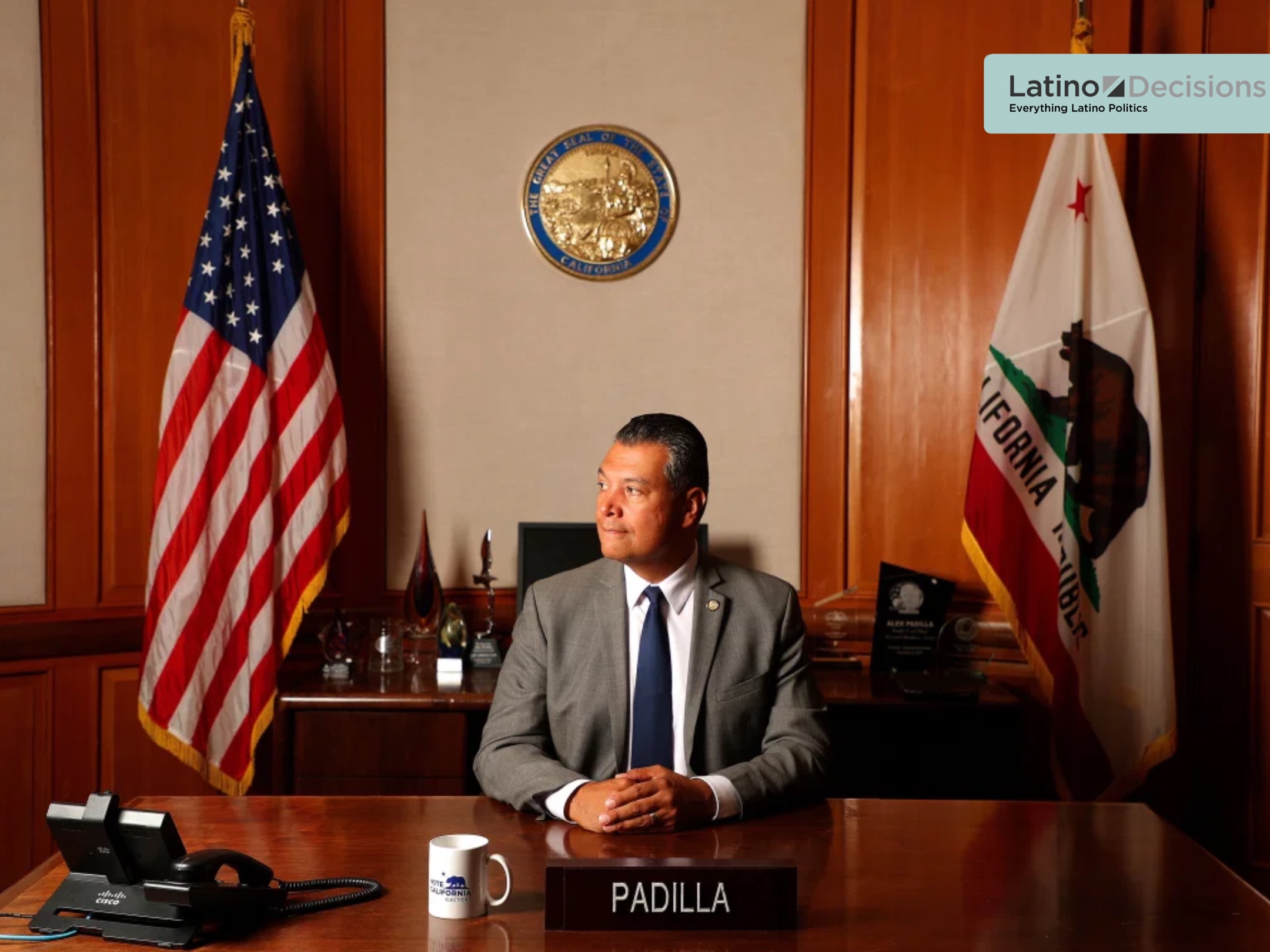Earlier today, America’s Voice and Latino Decisions released the first of three waves of national polling of the Latino electorate (tomorrow there will be releases for Colorado, Florida, and Nevada; to access the national toplines click here and to access the accompanying slide deck click here). The polling of 2,200 registered Latino voters was conducted with bilingual interviews using a mix of land, cell, and web-based interviews. The poll’s margin of error is +/- 2.1 percentage points. In addition to the results discussed below, the poll includes summaries of head-to-head match ups between the Democratic presidential candidates, Hillary Clinton and Bernie Sanders, and their Republican counterparts, Donald Trump and Ted Cruz, as well as vote preferences for the U.S. Senate and House of Representatives.
The survey was designed to measure how immigration policy and politics are shaping the views of Latino voters as the 2016 election approaches. As the results presented in Figure 1 indicate, immigration is the animating issue for many Latino voters. In response to a split-sample open ended question, better than two in five respondents (41%) indicated that immigration reform and deportations are the most important issue facing the Latino community that should be addressed by Congress and the president — topping the economy and jobs (24%), education reform (16%), and health care (8%). Another 10% of voters cited anti-Latino attitudes and racial/immigrant discrimination. Consistent with prior polling, there is no evidence that social issues such as abortion, gay marriage, and family values resonate as political issues among Latino voters.
Note that when the most important issue question is asked without the prompt “facing the Latino community” jobs and the economy increase to 36%, while immigration drops to 29%. Taking into account the larger margin of error for the split-sample, these differences are statistically significant and suggest some differentiation in the issue priories that Latinos assign to the country as a whole as compared to those facing the Latino community. At the same time, these differences are a manner of degree.
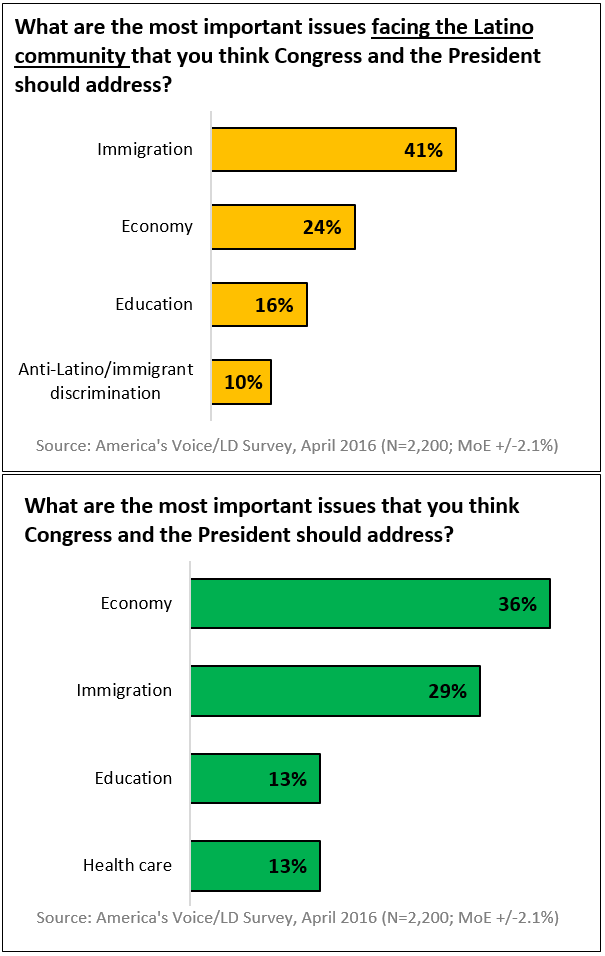
One of the main findings of the poll is how the parties and their presidential candidates are addressing immigration is reverberating loudly among Latino voters. Figure 2 summarizes the responses to a split-sample question asking if in recent years the parties have become more welcoming to Latinos, become more hostile, or have not changed. Over three times as many respondents indicated that the Democratic Party has become more welcoming as compared to the GOP. In contrast, just one in ten Latino voters thinks that the Democrats have become more hostile as compared to 42% holding such views towards the Republican Party.
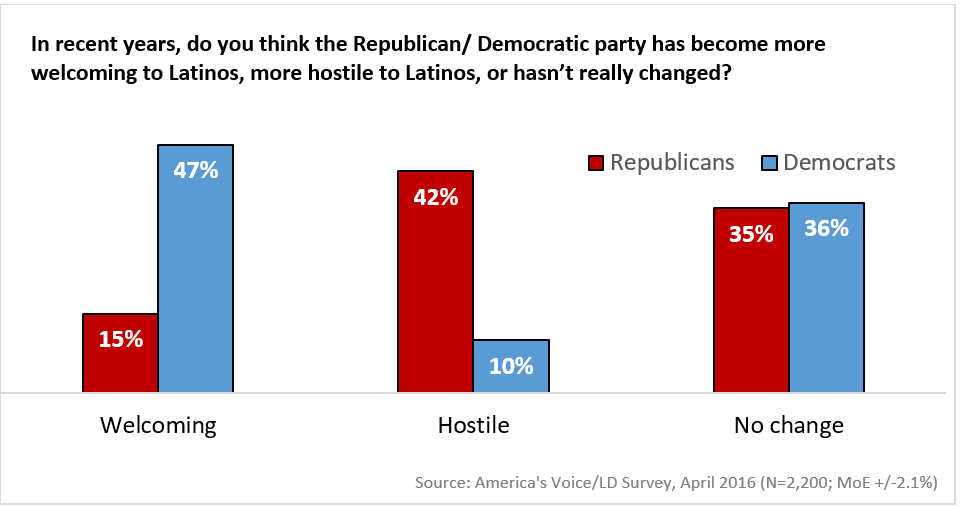
Consistent with the broader perceptions of the Democratic and Republican Parties, as Figure 3 summarizes, Latino voters have diverging opinions of the parties’ presidential candidates. Specifically, the figure reports the share of respondents having either a very or somewhat favorable opinion or very or somewhat unfavorable opinion of Clinton, Sanders, Trump, Cruz, and John Kasich. While both Democratic candidates have total favorable ratings above 60%, among the GOP candidates, only Cruz has a favorability rating exceeding 30% and all three Republicans are viewed more unfavorably than favorably. The difference between Cruz’s favorable and unfavorable total is -16 percentage points and for Kasich, this difference is -10 points (better than a third of respondents have either never heard of Kasich or have no opinion of the Ohio governor). However, for Trump, the difference is -78 points as 87% of Latino voters have either a very or somewhat unfavorable opinion of Trump as compared to 9% of who view him as very of somewhat favorable.
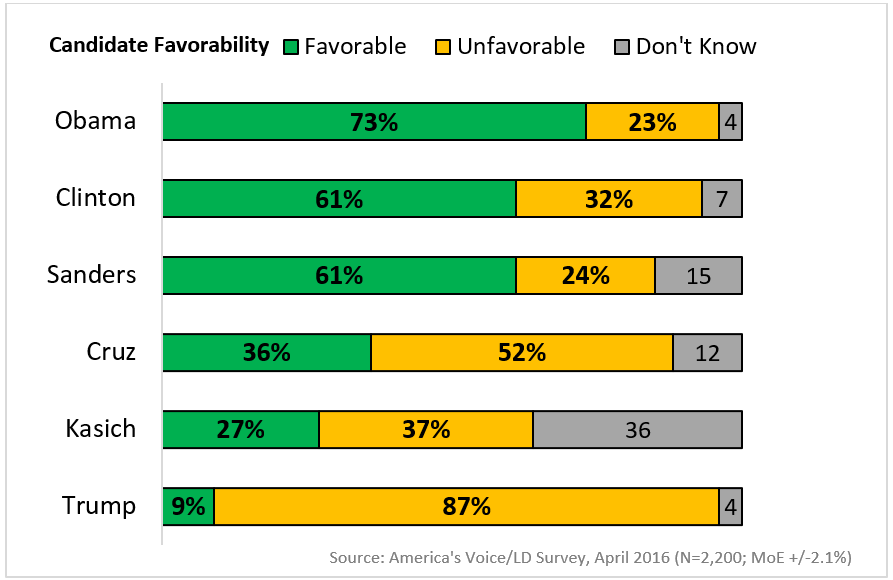
The full survey results also include scales measuring the degree to which the presidential candidates are pro or anti-immigrant or immigration and how the candidates’ views towards immigrants and immigration are likely to impact vote choice in the fall.
In light of this week’s Supreme Court hearing in the United States v. Texas case challenging President Obama’s authority to use executive power to provide relief from deportation for undocumented immigrants who meet the DACA or DAPA qualifications, the results presented in Figures 4 and 5 are of particular import. The figures summarize the impact that the Democratic presidential candidates’ support for DACA and DAPA and the Republican presidential candidates’ opposition to these policies has on the presidential vote.
As both figures make clear, the Republican presidential candidates’ opposition to these policies and the Democratic presidential candidates’ support for DACA and DAPA has a strong affect on how Latinos are likely to vote in November. Just 12% of respondents indicated that the Republican presidential candidates’ opposition to DACA would make them much more likely or somewhat more likely to vote Republican in November, while 73% responded that this would make them much less or somewhat less likely to vote Republican in November.
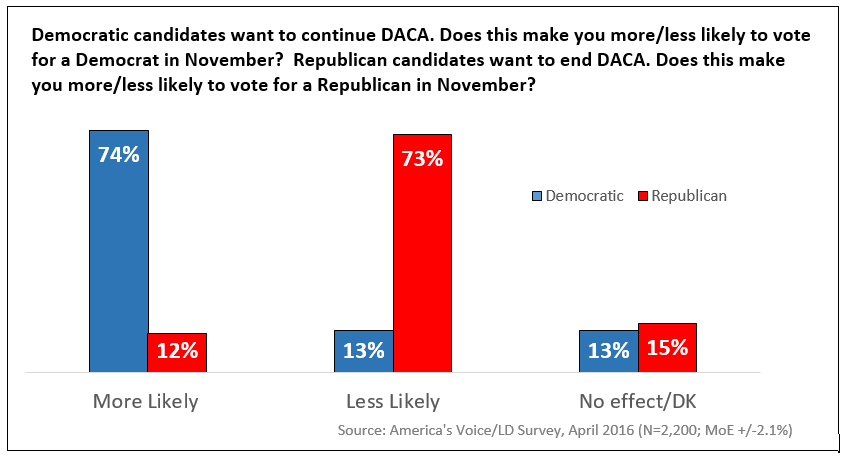
The opposite holds for the Democrats as nearly three-quarters of those surveyed responded that the Democratic presidential candidates support for DACA made them much more or somewhat more likely to vote Democratic in November, with just 13% indicating this would make the much less or somewhat less likely to vote Democratic. The same patterns also extend to the candidates’ views towards DAPA.
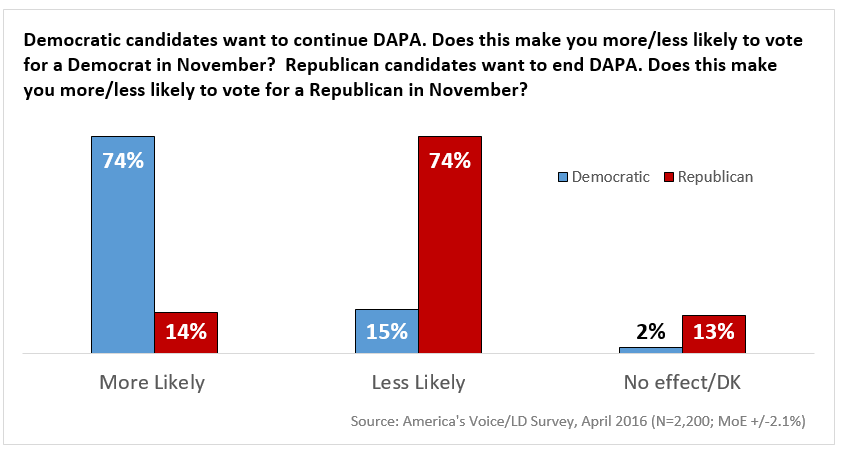
These results underscore the degree to which immigration policies and by extension, politics affect the lives of many Latino voters: 57% of those surveyed indicated that they know a friend, family member, co-worker, or other relationship who is an undocumented immigrant; 34% know someone who is facing immigration related detention or deportation; and a third of respondents know someone who applied for DACA.
Lastly, the results highlight the deleterious effect that Donald Trump’s candidacy has on the GOP’s prospects of cutting its margins with Latino voters. Not surprisingly, 87% of a split- sample responded that Trump’s call for using deportation forces to deport every undocumented immigrant made them much more or somewhat less likely to vote for Trump. More telling, the data in Figure 5 suggest that Trump is the main cause of increased enthusiasm among Latinos to vote in 2016: nearly half (48%) of Latino voters reported being more enthusiastic about voting in November as compared to four years ago and among this component of the Latino electorate, over 40% cited Trump and anti-Latino rhetoric as the main reason why!
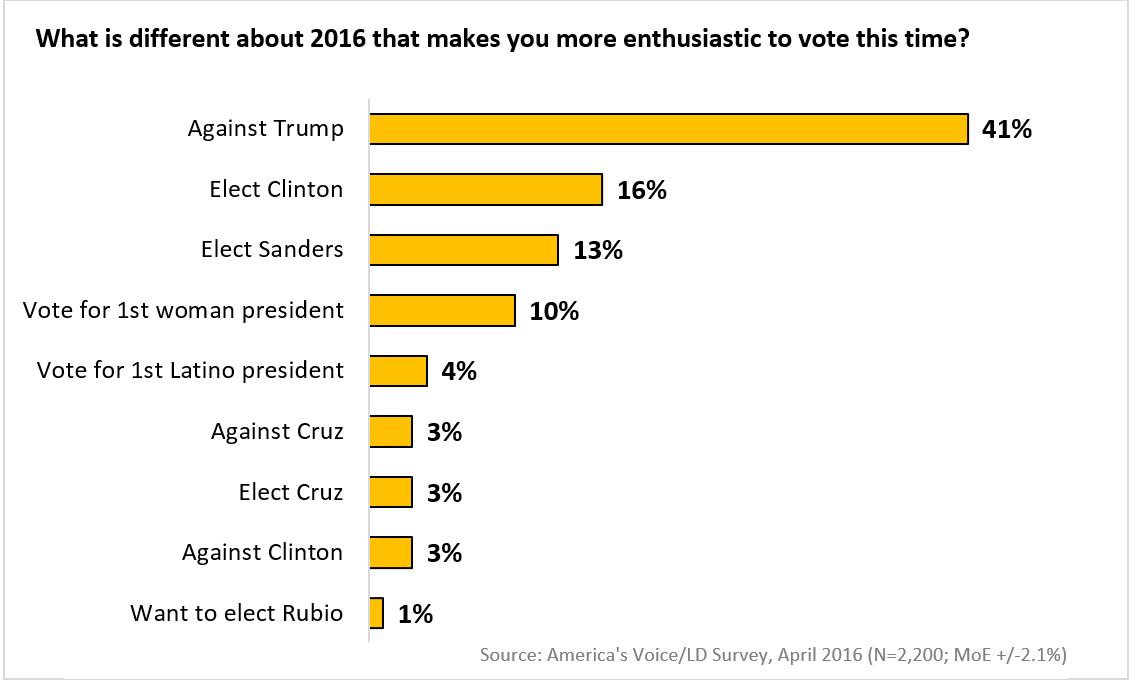
More broadly, the data presented here are consistent with a nationalization of the “Prop 187 Effect” — the political backlash resulting from the Republican’s embracement of anti-immigrant policies and rhetoric in California in the 1990s. As we have documented elsewhere, a series of ballot measures hostile to immigrants that were pushed by the GOP led to increased political participation and increased rates of naturalization among Latino voters, as well as the movement away from the party among whites and other minorities. It is this set of dynamics, which occurred just as the state’s Latino population began to exert itself politically, that is most responsible for shifting California from a Republican to Democratic state in the last quarter century.
Last summer, America’s Voice and Latino Decisions developed simulations suggesting that the Republicans need 44% of the Latino vote nationally to secure the White House assuming typical increases in the size of the Latino vote. The degree to which Trump further enlarges the Latino electorate with voters who will not pull the lever for a Republican further diminishes the chance that a Republican will be elected to the presidency and creates the potential for erosion support further down the ballot. Indeed, in a number of immigrant-heavy communities, activists are using Trump’s attacks to as the basis of campaigns to increase naturalization among eligible immigrants prior to November.
Tomorrow, in the second part of our release, we consider how immigration politics and policy are affecting Latino voters in the key swing states of Colorado, Florida, and Nevada. All three of these states are not only key battlegrounds in presidential election, but in November they will also feature competitive U.S. Senate and House elections. Thus it is in these contexts where the parties and their candidates’ diverging approaches to immigration and immigrants are likely to have their most significant effects.
David Damore is a Senior Analyst at Latino Decisions. He is Associate Professor of Political Science at the University of Nevada, Las Vegas, and a Senior Nonresident Fellow in the Brookings Institution’s Governance Studies Program.

